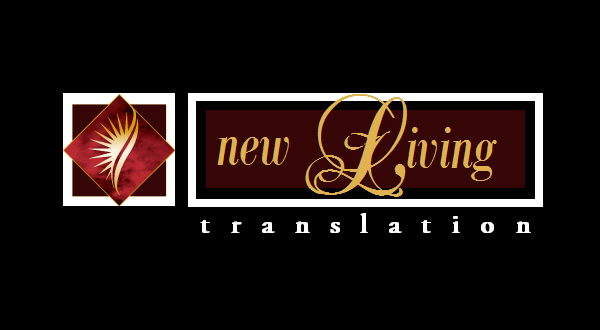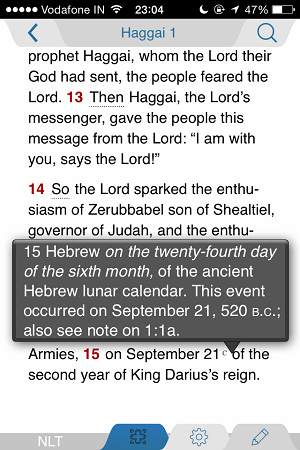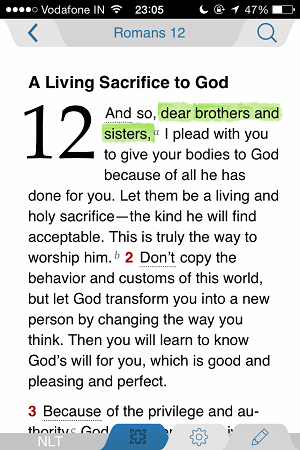Why I Prefer The New Living Translation (NLT) Bible!

Those who have been following my posts and sermons/ for a while would have, by now, noticed that I follow and use scriptures from the New Living Translation of the Holy Bible. I have been trying out different translations for a long time now. The one translation that has caught my heart is New Living Translation.
Here’s a little information about NLT Bible I found out, just to give you the background.
In 1989, ninety evangelical scholars from various theological backgrounds and denominations were commissioned to revise the Living Bible. The project began with the purpose of merely correcting parts of the Living Bible. However, as the 100 scholars began to work, the decision was made to complete an entirely new translation.
Taylor, the original author of the Living Bible, approved this decision, and plans were made for Tyndale Publishing House to print the New Living Translation. The purpose of the New Living Translation (NLT) was to make a translation that is accurate with the original languages, yet lively and dynamic. Bergen and the other translators worked independently to correct the Living Bible or produce new translations, then worked together to produce a joint translation. Every book of the New Living Translation was reviewed by three or four people, then rated in the areas of accuracy and clarity. The scholars would debate their opinions, informally vote on the best wording, and the editorial board would decide the final translation.
Each work of translation went through the channels of critique: the individual, a book committee, a general reviewer committee, and back to the individual. In 1994, the translators gathered again to make the revisions determined by the reviewers. Due to the extensive efforts put in by world-class Bible scholars, the New Living Translation is the most expensive translation project in the history of Bible translation.
Can I please highlight the few reasons for why I have stuck to NLT?
1. The Simplicity of Language
While I still prefer translations like ESV, AMP, KJV for the more crucial words that cannot be done away with, NLT has a way of explaining them in a way that would convey the exact, or closer to the exact, emotion. For instance, consider Romans 5:1 from the KJV and NLT Versions
KJV: Therefore, since we have been justified through faith, we have peace with God through our Lord Jesus Christ.
NLT: Therefore, since we have been made right in God’s sight by faith, we have peace with God because of what Jesus Christ our Lord has done for us.
Notice here, the explanation for the term ‘justified through faith’ as ‘made right in God’s sight by faith’. That is the tone and methodology adopted throughout the NLT Bible. Since, most attendees in my church, BRC are young, are new believers or are still seekers, a translation like the NLT helps facilitate the same.
2. The Dynamic Translation
The NLT Bible’s predecessor is the Living Bible, which was more of a paraphrased version.
There are two types of Bible translations, one is word to word translation, like the KJV and the ESV, the other is paraphrased or the Dynamic translation, like the NIV or the NLT.
In such translations, the text is translated phrase to phrase instead of word to word, to try and maintain the intent of the original text. The dynamic equivalence in NLT is splendid. Although, not perfect, NLT is nearly as accurate as a paraphrased version can get. Other dynamic translations like NIV and Message, although widely used, are very different from NLT. The reason being that though NLT uses our everyday English language, it doesn’t go to the extreme of paraphrasing the entire passage, like the message bible does.
3. The Richness of the Text
Most preachers won’t agree with me on this, and wouldn’t want to refer to NLT especially for teaching or preaching purposes. I can completely understand the same, since the word to word translation are better for more revelation based sermons. NLT is extremely helpful, when it comes to doing a lot of practical teaching, because it translates into our every day spoken English language.
Some argue, that CEV is a much better version when it comes to the richness of the text. I wouldn’t argue against it. I’d leave that up to you to read and decide as to which suits your taste and language better.
Here’s an example:
Habakkuk 3:17-18 NLT
[17] Even though the fig trees have no blossoms, and there are no grapes on the vines; even though the olive crop fails, and the fields lie empty and barren; even though the flocks die in the fields, and the cattle barns are empty, [18] yet I will rejoice in the Lord! I will be joyful in the God of my salvation!
4. Gender Neutrality & Synchronization of Dates
Check out the screeshots below:
That’s what NLT does throughout the Bible. The translation neutralizes the gender, and also tells us the dates in a language that we can understand. Gender neutralizing is seen by some as addition to the scripture, but I don’t see that as a valid argument. Because all of scriptures are equally addressed to both brothers and sisters. Because, the apostles addressed the brothers as was appropriate in their times and context, it can surely be appropriately addressed to both brothers and sisters in our day and age.
5. Where to get one?
Are you wondering where to get an NLT Bible? If you have never tried NLT, then first give it a try using the online version on Tecarta Bible or YouVersion Bible app on your phones or tablets. If you like it, you can surely purchase a downloadable version on Tecarta or if you need a print version, then on Flipkart or Amazon.
Do let me know, if this post helped you in your hunt or desire for an apt Bible translation for your personal or group usage. At our church and home groups, NLT is the Bible translation we adopt and use. Look forward to hearing from you!




True, NLT is one of the easy to read translations of the Bible . It is always best to use the NKJV (some prefer KJV) the original translations to not lose the value of the text. Example,
John 15:2 NLT says He ‘cuts off’ every branch of Mine that doesn’t produce fruit….
John 15:2 NKJV says Every branch in Me that does not produce fruit, He ‘takes away’..
The meaning of the text ‘takes away’ is lifting up is retained in NKJV/KJV. There are other passages too in translation where the word or sentence, when translated loses part of its meaning or is cut off. For preaching, teaching and studying, NKJV/KJV is needed. Other translations are easy to follow for audience on sunday service or self reading.
Hi Juliet, I understand your perspective. Thanks for sharing the same. When it comes to accuracy of text, I prefer ESV, cause of the manuscripts used for the translation is more authentic. While KJV/NKJV depends more on the traditional manuscripts. And especially for conflicts of words or understanding it any better Amplified comes in as the ultimate help. I prefer NLT cause of the dynamic (phrase to phrase) translation. Whereas KJV/NKJV/ESV is a literal word to word translation.
I prefer NKJV or ESV. Tried reading some portions of NLT and comparing. It seems too simplified. Since I have been using the other versions for long now, seems difficult to read NLT. For example, feels difficult to accept Psalms 23 in NLT now.
Hi Robert,
Yes, I completely understand. Someone who is very used to a word to word translation, will find this very difficult to read and absorb. But it will be a great tool for someone you newly introducing the bible to. Thanks for sharing!
Would you say there is a difference between the old Catholic church saying only the leaders of the church can understand and translate the Bible and the modern translators presuming they know the best explanation rather than letting the Word speak for itself?
Also – I’ve never understood the need to add “sisters.” If it’s really so simple an explanation, why can’t people just take it as it is and understand the basic cultural context?
Yes, people can easily understand the context. But it becomes very easy for first timers to relate to the bible, when they read it as Brothers & Sisters!
Yes, there is a great difference. And it is that modern translations and their translators are open to change and challenge.
I’ve struggled for years trying to understand the Bible , then I purchased the NLT, it has opened the Bible for me. I’m not a Bible scholar, I just want God to speak to me thru his word, and he had with the NLT. I once read a comment as to which Bible translation was the right one and the answer was “what ever translation you always come back to” .
Hi Priji, when I was not a Christian a brethren friend gave me a bible in 1990 or 91 and it made a lot of sense to me then, He soon left college as he was my senior and we lost contact, then I became a Christian, ever since I have been searching for the version he gave me and I now think it is NLT. two weeks ago I was studying Rom 5 for a bible study group and I used NKJV, NIV, ESV and then each verse I converted into simple English for my own understanding. It was hard work but it gave me good insight, then in the bible study group while we were stuck on a verse someone read from the NLT, and that was a real ahh…. moment for me. So i have been doing some digging about NLT and thank you for this write up, its been very helpful for me.
I absolutely agree with you. The NLT is the perfect version for a straight read. It is not a great version for deep study but a parallel Bible with NLT and KJV covers the entire spectrum. I love the NLT. It is perfect for the spiritual intellect of the current church.
Thank you for this wonderful article. I agree that the NLT is a great version for the modern day church. It’s not an insult to say the church is slowely falling into a slumber as that is a prophesied event in the last churcvh ages. The NLT is the perfect book to sow the seed of understanding. Once you can grasp a concept, then you can break it down further with more complicated versions. My Bible is a parallel with KJV and NLT…that covers a large spectrum. Throw in the NASB and you got yourself a great platform for study.